I would like to implement the code below avoiding for loops to increase speed. Is there any way to do this so that I can create a sphere centered in the numpy array?
def Create_Sphere(square_numpy_array, pixel_min, pixel_max, HU, Radius_sq ):
new_array = np.empty_like(square_numpy_array)
for k in range(pixel_min, pixel_max, 1):
for i in range(pixel_min, pixel_max, 1):
for j in range(pixel_min, pixel_max, 1):
r_sq = (i - 255)**2 + (j - 255)**2 + (k - 255)**2
if r_sq <= Radius_sq:
new_array[k, i, j] = HU + 1000
return new_array
Adopting the solution from the recommended link Python vectorizing nested for loops I was able to replace the code. I am getting unexplained artifacts in the final plot however. There are rings appearing around the central sphere. What could be causing these?
def Create_Sphere_CT(HU=12):
radius = np.uint16(100) #mm
Radius_sq_pixels = np.uint16((radius *2)**2 )
sphere_pixel_HU = np.uint16(HU + 1000) #dtype controlled for memory
center_pixel = np.uint16(400/2-1)
new_array = np.zeros((400,400,400), dtype = np.uint16)
m,n,r = new_array.shape
x = np.arange(0, m, 1, dtype = np.uint16)
y = np.arange(0, n, 1, dtype = np.uint16)
z = np.arange(0, r, 1, dtype = np.uint16)
xx,yy,zz = np.meshgrid(x,y,z, indexing = 'ij')
X = (xx - center_pixel)
xx = None #free memory once variable is used
Y = (yy - center_pixel)
yy= None #free memory once variable is used
Z = (zz - center_pixel)
zz = None#free memory once variable is used
mask = (X**2 + Y**2 + Z**2) < Radius_sq_pixels #create sphere mask
new_array = sphere_pixel_HU * mask #assign values
return new_array
This code give a sphere centered with some ring artifacts around
